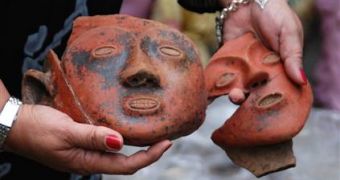Some smugglers from Philippine were trying to transport 22 bags of ancient pottery out of the country, in order to sell it abroad for a large sum of money. The local police captured them, together with the unearthed goods, but the antique pieces of pottery proved to be a big surprise for experts. The scientists at the National Museum in Manila (the capital city of the Philippines) claim that they are actually burial urns of a long-lost tribe living in the area more than 2 millennia ago. In an interview to Reuters, Eusebio Dizon, National Museum's head of the archaeological unit, stated that the designs on the pottery proved the tribe was different from any others.
“The pottery has human faces that show emotions,” he explains. “The Manobos, Tirurays and B'laans tribes that have survived over time do not bury their dead in painted anthropomorphic (human form) jars. So, we have no idea what kind of people are behind these unique burial jars.” They are also much older than other previous similar findings. “We have no idea where these artifacts come from because the people who were trying to smuggle them out from the area could not tell us where exactly they found those materials. But, I am sure the materials are not fake,” adds the expert.
As a result of previous digging activities, other ancient items were found at the location, such as weapons, artifacts or clay vessels dating from the Stone Age. Still, according to Dizon, “anthropomorphic pottery is seldom seen in this part of the world.” As the governor of the Sarangani province, Rene Miguel Dominguez, states, the discovery was made in the region of the Palembang town, on the coast, in the proximity of the Sultan Kudarat province, which is well-known for the violent activity of Muslim rebels.
This is the most difficult challenge that the Philippines government and the National Museum face: securing the area from violent outbursts, dealing with the Muslim rebels who claim large sums of money for access to the area, unearthing the archaeological evidence, and protecting it from the smugglers who dream of getting rich by selling it abroad. Currently, there are not enough financial resources to ensure a successful outcome for all these strategies.

 14 DAY TRIAL //
14 DAY TRIAL //